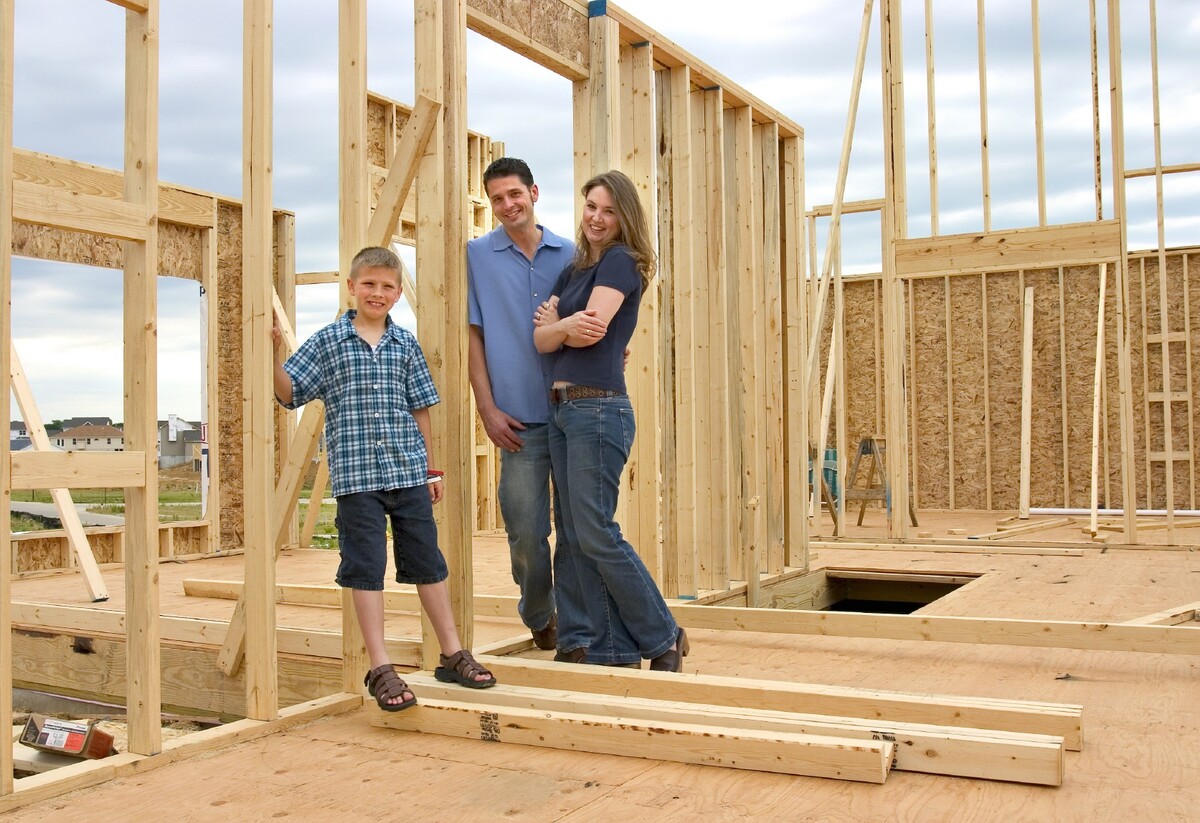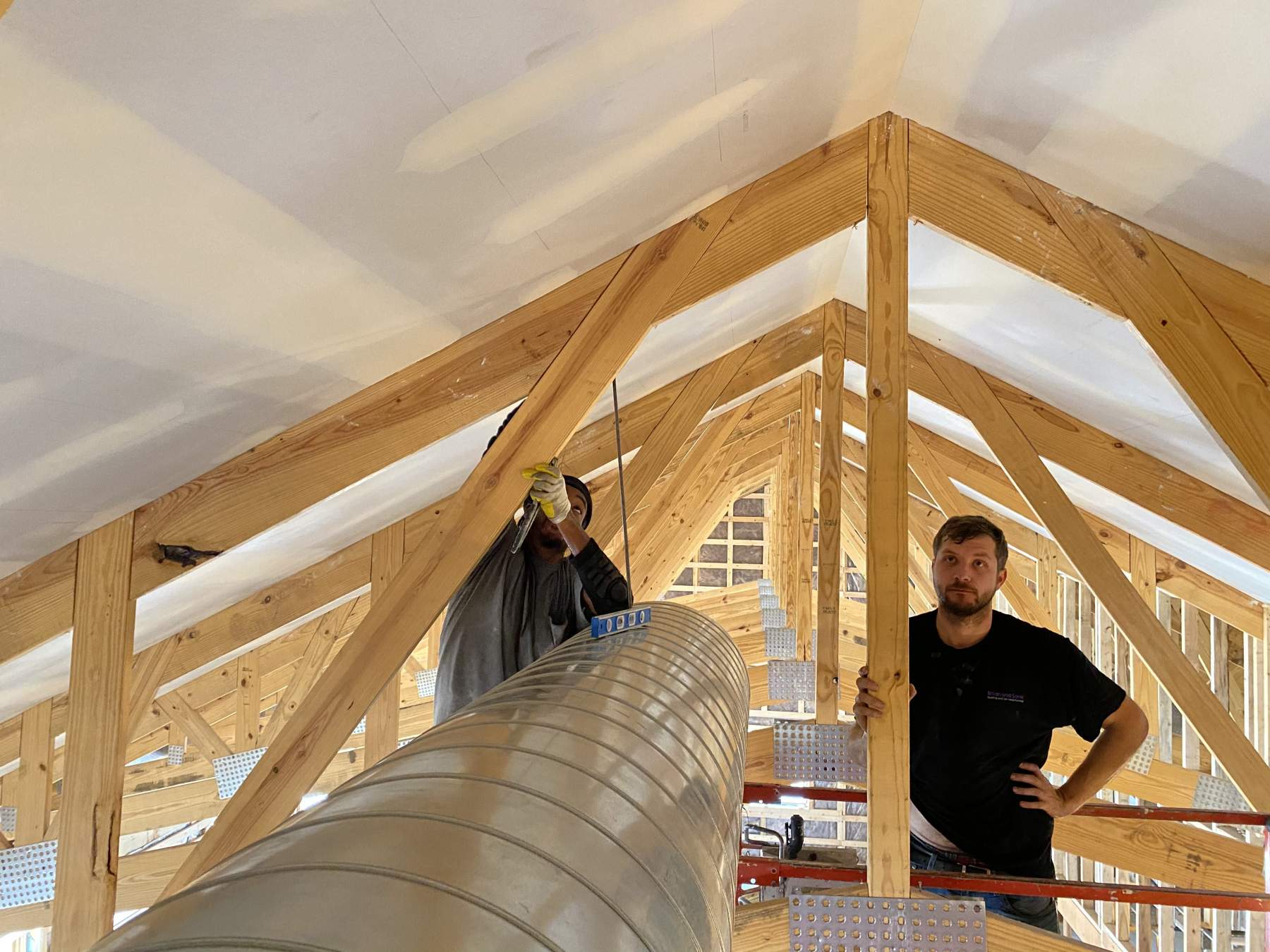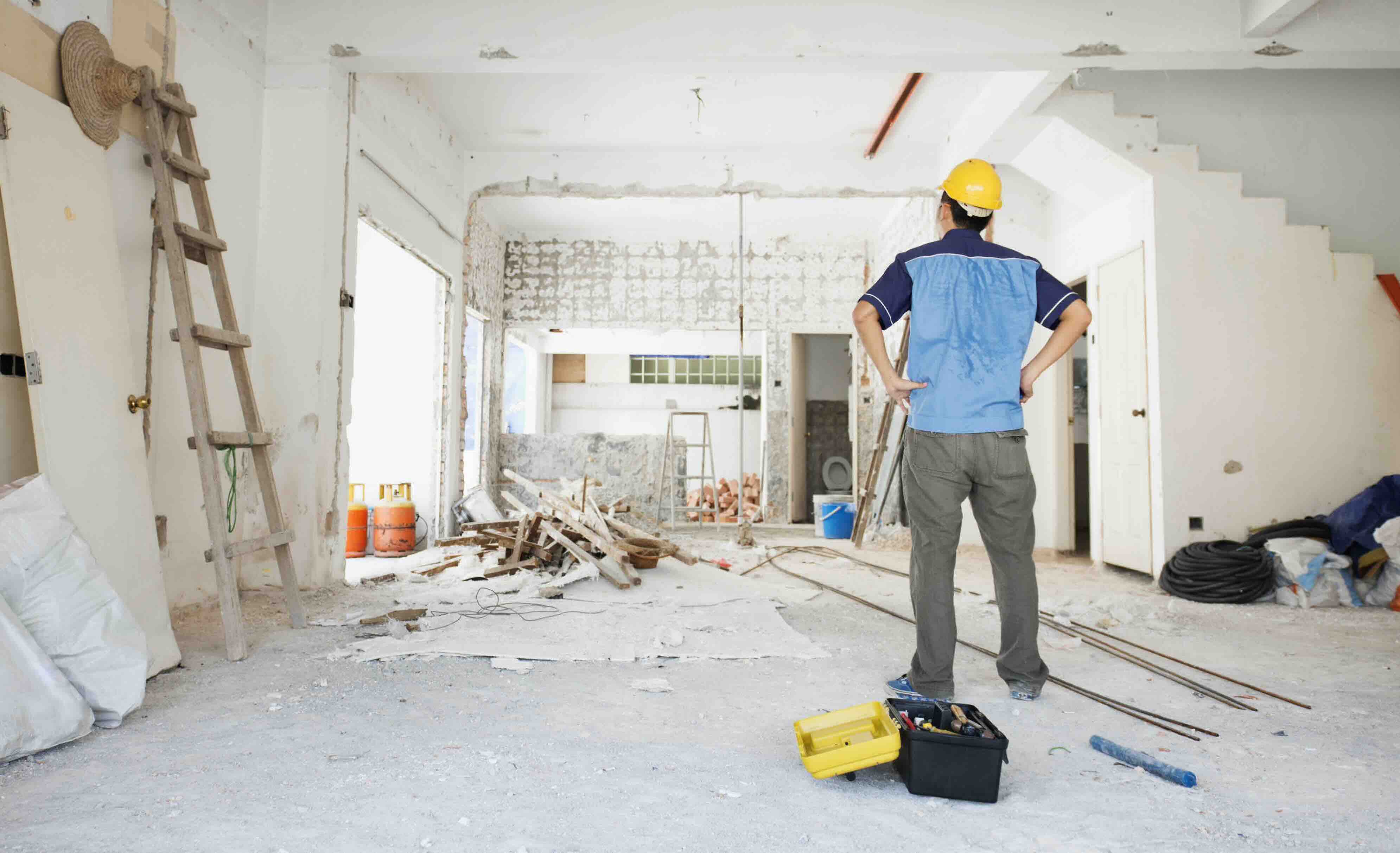Home>diy>Building & Construction>Checklist When Building A New Home


Building & Construction
Checklist When Building A New Home
Modified: October 31, 2024
Ensure a smooth construction process and successful home build with this comprehensive checklist for building a new home. Find tips and recommendations for every step of building-construction.
(Many of the links in this article redirect to a specific reviewed product. Your purchase of these products through affiliate links helps to generate commission for Storables.com, at no extra cost. Learn more)
Introduction
Welcome to the exciting journey of building your dream home! Whether you’re a first-time homeowner or looking to upgrade, constructing a new home offers endless possibilities for customization and personalization. But before you dive into the construction process, it’s crucial to have a comprehensive checklist to ensure a smooth and successful building experience.
In this article, we will guide you through the key factors to consider when building your new home. From budgeting and financing to selecting the perfect location and finalizing the finishing touches, we will cover everything you need to know to make informed decisions and create the home of your dreams.
Building a home is a substantial investment, both financially and emotionally, so it’s important to approach it with careful planning and preparation. By following this checklist, you can mitigate risks, avoid costly mistakes, and ensure that your new home is built to meet your specific needs and preferences.
Throughout the article, we will discuss various aspects of the home building process, including selecting the right builder, designing the layout, choosing essential structural elements, and making decisions regarding electrical and plumbing systems, heating, ventilation, and air conditioning, insulation, and energy efficiency. We will also touch upon interior and exterior finishes, flooring and wall coverings, cabinets and countertops, appliances and fixtures, as well as lighting and electrical outlets.
Additionally, we will explore the importance of landscaping and creating welcoming outdoor spaces, consideration around safety and security features, final inspections and permits needed, and tips for ensuring a smooth transition when moving into your new home.
So, without further ado, let’s dive into our comprehensive checklist for building the perfect home!
Key Takeaways:
- Building a new home involves careful planning, budgeting, and selecting the right builder. From safety features to landscaping, attention to detail ensures a smooth and rewarding journey.
- Moving into a new home requires patience and organization. Familiarize yourself with systems, personalize your space, and embrace the process of turning a house into a home.
Read more: Tips When Building A New Home
Budgeting and Financing
One of the first and most crucial steps in building a new home is creating a realistic budget and securing the necessary financing. Before you begin any construction, it’s essential to have a clear understanding of your financial situation and explore your options for funding.
Start by determining how much you can afford to spend on your new home. Consider your current income, savings, and any additional sources of funding, such as loans or grants. Factor in expenses such as land acquisition, construction costs, permits, surveys, and architectural fees.
It’s important to set a realistic budget that allows for unexpected expenses and potential changes along the way. Consider consulting with a financial advisor or mortgage specialist to help assess your financial capabilities and explore financing options.
When it comes to financing, you have several choices, including traditional mortgages, construction loans, or personal savings. Compare interest rates, repayment terms, and eligibility requirements to choose the option that best suits your needs.
Another aspect to consider when budgeting is the cost of ongoing maintenance and utilities. A larger home or specific features may require more upkeep and result in higher energy bills. Keep this in mind when making decisions about the size and design of your new home.
Creating a detailed budget and sticking to it will help you prioritize your expenses and make informed decisions throughout the construction process. Keep track of costs and regularly review your budget to identify any potential overspending or areas where adjustments can be made.
Finally, it’s crucial to build a contingency fund into your budget. Unexpected issues or changes may arise during construction, and having extra funds set aside will provide a safety net. Aim for a contingency of at least 10% of your total budget to cover any unforeseen circumstances.
By taking the time to carefully plan your budget and secure adequate financing, you can start your home building journey with confidence and peace of mind, knowing that your financial foundations are solid.
Choosing the Right Builder
When it comes to building your dream home, selecting the right builder is crucial. The builder you choose will play a significant role in the success, quality, and overall experience of your home construction project. Here are some key factors to consider when choosing a builder.
First and foremost, do your research. Look for reputable builders in your area with a proven track record of delivering high-quality homes. Check online reviews, ask for recommendations from friends, family, or real estate professionals, and visit previous projects if possible.
Verify that the builder is licensed, insured, and bonded. These credentials ensure that they meet the necessary legal requirements and have the financial resources to complete your project. It’s also crucial to confirm that the builder has experience in constructing the type of home you desire, whether it’s a single-family home, townhouse, or custom design.
Take the time to interview potential builders. Ask about their building process, timeline, and communication methods. A builder who is transparent, responsive, and accessible will make the construction journey much smoother.
Request and review their portfolio or sample floor plans to ensure that their design aesthetic aligns with your vision for your new home. Additionally, inquire about their subcontractors and suppliers to ensure that they work with reputable professionals who uphold the same standards of quality.
Ask for references from past clients and contact them to get their feedback on the builder’s work ethics, communication skills, and overall satisfaction. Taking the time to speak with previous clients will provide valuable insights into what it’s like to work with the builder.
Obtain detailed cost estimates and contracts from potential builders. The estimate should include a breakdown of all costs, such as materials, labor, and permits. Carefully review the contract terms, payment schedules, and warranty policies before making a decision.
Lastly, trust your instincts. Building a home requires a close working relationship with the builder, so choose someone who instills confidence, communicates effectively, and understands your unique requirements.
Remember, building a home is a long-term investment, so it’s essential to choose a builder you can trust and feel comfortable working with. By taking the time to find the right builder, you’re setting the stage for a successful and satisfying home building experience.
Selecting the Perfect Location
Choosing the right location for your new home is just as important as the design and construction process. The location will have a significant impact on your daily life, accessibility, and even the resale value of your home. Here are some key factors to consider when selecting the perfect location for your new home.
Consider your lifestyle and priorities. Do you prefer a bustling urban area with easy access to amenities and entertainment? Or do you long for a quiet suburban neighborhood with a sense of community? Think about what you value most in a location and what type of environment would best suit your needs.
Evaluate the proximity to schools, healthcare facilities, and shopping centers. If you have children or are planning to start a family, being near good schools and medical services is essential. Access to grocery stores, restaurants, and other conveniences should also be taken into account.
Think about your commute. Consider the distance to your workplace and the availability of public transportation options. A long and stressful daily commute can significantly impact your quality of life, so it’s important to choose a location that minimizes travel time and offers convenient transportation alternatives.
Examine the safety and security of the neighborhood. Look for low crime rates, well-lit streets, and a proactive community that values safety. Consider visiting the area at different times of the day to get a sense of the neighborhood’s atmosphere and overall vibe.
Assess the future development plans and potential for growth in the area. While you may enjoy the tranquility of a remote location, it’s essential to consider the long-term prospects. Look for upcoming infrastructure projects, new businesses, or planned residential developments that could affect the value and livability of the area.
Take the time to explore the natural surroundings and outdoor amenities. Are there parks, hiking trails, or recreational facilities nearby? Being close to nature and having access to outdoor activities can significantly enhance your quality of life and provide opportunities for relaxation and recreation.
Consider the overall neighborhood aesthetics and architectural style. Look for cohesive design elements, well-maintained homes, and a sense of pride in the community. Ensure that the architectural guidelines align with your vision for your new home and that there are no restrictions or limitations that could hinder your customization plans.
Lastly, don’t forget to factor in your budget. Location plays a significant role in determining the cost of land and potential property values. Take into account the affordability of the area and the future appreciation potential of your investment.
By carefully considering these factors and doing thorough research, you can select the perfect location for your new home. Remember, finding the right neighborhood is about more than just the physical location; it’s about finding a place that feels like home and meets your unique needs and aspirations.
Designing the Layout
The layout of your new home is an essential element in creating a functional and comfortable living space. It involves carefully planning the arrangement of rooms, flow between spaces, and optimizing the use of available square footage. Here are some key considerations when designing the layout of your new home.
Start by envisioning your ideal living spaces. Consider the number of bedrooms, bathrooms, and any additional rooms you may need, such as a home office, gym, or playroom. Think about the desired size and placement of each room and how they will be used in your daily life.
Consider the flow of the home. Aim for an intuitive and logical arrangement that allows for easy movement between rooms. Avoid long and narrow hallways or excessively segmented spaces that can make the home feel cramped and disconnected.
Take advantage of natural light. Position windows strategically to maximize natural light throughout the day. Consider the orientation of the home and how it will affect the distribution of sunlight in different areas. This not only enhances the aesthetics but also promotes energy efficiency and a healthy living environment.
Think about the relationship between indoor and outdoor spaces. If you have a backyard or patio area, design the layout to create a seamless connection and access to these outdoor areas. This can be achieved through sliding glass doors, large windows, or outdoor living spaces.
Consider the placement of utility areas. Ensure that the laundry room, storage spaces, and garage are easily accessible and conveniently located in relation to the main living areas. This will make everyday tasks more efficient and enhance the overall functionality of the home.
Explore open concept designs. Open floor plans have become increasingly popular, as they create a sense of spaciousness and allow for better interaction between family members and guests. However, balance is key, as some privacy and separation between rooms may still be desired for certain activities.
Think about future flexibility. Consider design elements that allow for potential changes in your lifestyle or needs. For example, a flexible space that can easily be converted into a guest room or home office, or a room that can serve multiple purposes, such as a playroom or study area.
Create storage solutions. Adequate storage is essential for keeping the home organized and clutter-free. Incorporate built-in cabinets, closets, and shelving units into the layout to optimize storage space without sacrificing aesthetics.
Seek professional advice. Consulting with an architect or interior designer can provide valuable insights and expertise in designing the layout of your new home. They can help you create a functional and visually appealing design that complements your lifestyle and preferences.
Remember, the layout of your home sets the foundation for how you will live and move within the space. Taking the time to carefully plan and design the layout will result in a home that is both functional and personalized to your unique needs and style.
Read more: Mistakes To Avoid When Building A New House
Determining the Structural Elements
When building a new home, determining the structural elements is a critical step in ensuring the longevity, safety, and overall integrity of your home. These elements make up the skeleton of the building, providing support and stability. Here are some key considerations when determining the structural elements of your new home.
Foundation: The foundation is the base upon which your home is built. It provides stability and transfers the weight of the structure to the ground. Consider factors such as soil conditions, climate, and building codes when choosing the appropriate foundation type, whether it be a slab-on-grade, crawl space, or full basement.
Structural Framing: Structural framing consists of beams, columns, and walls that support the floors, walls, and roof of your home. Materials commonly used for structural framing include wood, steel, or concrete. Each material has its advantages and considerations, such as cost, durability, and ease of construction.
Roofing System: The roofing system protects your home from the elements and plays a crucial role in energy efficiency. Choose a roofing material that suits the architectural style of your home, climate conditions, and personal preferences. Options range from traditional asphalt shingles to metal, tile, or slate.
Exterior Walls: Exterior walls not only provide structural support but also act as the first line of defense against the elements. Consider the materials and insulation used in the exterior walls to ensure energy efficiency and durability. Common options include wood framing with various types of siding or masonry construction.
Flooring Systems: The flooring system encompasses the structural components that support the floors in each level of your home. The choice of flooring materials, such as hardwood, tile, or carpet, will depend on personal style, comfort, and functionality.
Windows and Doors: Windows and doors are crucial elements in the structural integrity and energy efficiency of your home. Choose quality materials that offer proper insulation and consider factors such as natural light, ventilation, and security when selecting window and door types.
Load-Bearing Walls: Load-bearing walls carry the weight of the structure above them. Careful consideration must be given to their placement and design to ensure the structural integrity of the home. Seek professional guidance from a structural engineer or architect to determine load-bearing walls and incorporate them into the overall design.
Plumbing and Electrical Systems: While not technically structural, plumbing and electrical systems play a significant role in the overall functionality and safety of your home. Plan the routing and installation of pipes, wires, and fixtures to ensure efficient flow and access to necessary utilities.
Comply with Building Codes: It’s essential to consult local building codes and regulations to ensure compliance when determining the structural elements of your home. Building codes dictate requirements for safety, structural integrity, and energy efficiency, and adherence to these standards is crucial to obtain the necessary permits and approvals.
Working with a team of professionals, including architects, structural engineers, and contractors, will help ensure that the structural elements of your home are chosen and implemented correctly. By considering these factors and seeking expert advice, you can create a home with a strong foundation and solid structural design.
Electrical and Plumbing Systems
The electrical and plumbing systems are crucial components of any new home construction project. These systems ensure the functionality, convenience, and comfort of your home. Here are some key considerations when designing and installing the electrical and plumbing systems in your new home.
Electrical System:
- Consult with a licensed electrician to plan the electrical layout of your home. Consider your current and future power needs, including the number of outlets, lighting fixtures, and appliances that will require electricity.
- Determine the location of electrical panels, circuit breakers, and outlets to ensure accessibility and meet local building codes.
- Consider energy efficiency by incorporating LED lighting, dimmer switches, and programmable thermostats to reduce energy consumption and lower utility bills.
- Plan for the integration of smart home technology, such as automated lighting and security systems. Ensure proper wiring infrastructure is in place to accommodate these systems.
- Install ground fault circuit interrupters (GFCIs) in areas where water is present, such as bathrooms, kitchens, and outdoor outlets, to provide protection against electrical shocks.
- Consider the need for backup power by installing a generator or designing the electrical system to accommodate future generator installation.
Plumbing System:
- Design the plumbing layout to optimize water flow and efficiency. Consider the number of bathrooms, kitchen fixtures, and outdoor water connections.
- Work with a licensed plumber to install durable and reliable plumbing materials, such as copper or PEX piping, to prevent leaks and ensure long-term functionality.
- Ensure proper ventilation and drainage by installing vents and traps to prevent the buildup of harmful gases and odors.
- Incorporate water-saving features like low-flow fixtures and dual-flush toilets to conserve water and reduce water bills.
- Install shut-off valves and access panels for easy maintenance and repairs.
- Consider incorporating energy-efficient options like a tankless water heater to provide hot water on demand and reduce energy consumption.
When planning the electrical and plumbing systems, it is essential to work closely with professionals who have experience in new home construction. They can guide you through the process, offer advice on energy efficiency and code compliance, and ensure that the systems are properly installed and meet all safety requirements.
By carefully designing and installing your electrical and plumbing systems, you can create a home that meets your specific needs, is energy-efficient, and provides a reliable infrastructure for years to come.
Heating, Ventilation, and Air Conditioning
The heating, ventilation, and air conditioning (HVAC) system is a vital component of a comfortable and energy-efficient home. It regulates temperature, controls humidity, and ensures proper airflow throughout the house. When designing and installing your HVAC system, consider the following factors:
1. Climate and Energy Efficiency: Take into account the climate in which your home is located. Choose an HVAC system that can effectively regulate temperature and humidity levels according to the local climate conditions. Opt for energy-efficient models that can reduce energy consumption and lower utility bills.
2. Size of the Home: Properly size your HVAC system based on the square footage and layout of your home. An undersized system may struggle to provide sufficient heating or cooling, while an oversized system can result in inefficient operation and unnecessary expenses.
3. Types of HVAC Systems: Consider the different types of HVAC systems available, including central heating and air conditioning, ductless mini-split systems, or hybrid systems. Each system has its advantages and considerations, such as cost, installation requirements, and energy efficiency.
4. Ventilation: Proper ventilation is essential for maintaining good indoor air quality and preventing the buildup of pollutants and moisture. Ensure that your HVAC system incorporates ventilation systems such as exhaust fans or mechanical systems to remove stale air and introduce fresh air into the home.
5. Zoning and Controls: Explore the option of zoned heating and cooling, which allows for different temperature settings in various areas of your home. This feature ensures individual comfort control and can lead to energy savings by only conditioning occupied zones.
6. Insulation and Air Sealing: Insulate your home properly to prevent heat or cool air loss. Use insulation in the walls, attic, and crawl spaces to reduce energy consumption and improve the efficiency of your HVAC system. Also, ensure that your home is sealed against air leaks to prevent drafts and maintain a consistent temperature.
7. Maintenance and Regular Servicing: Develop a maintenance plan for your HVAC system to ensure its longevity and efficiency. Regularly clean or replace filters, schedule professional inspections, and tune-ups to identify and address any potential issues before they become major problems.
8. Energy-Efficient Upgrades: Consider incorporating energy-efficient features into your HVAC system, such as programmable thermostats, smart controls, or geothermal heat pumps. These upgrades can help reduce energy consumption and provide more precise control over temperature settings.
Consult with HVAC professionals who can assess your specific needs, recommend the best system for your home, and ensure proper installation. They can also provide guidance on maintenance requirements and energy-efficient practices to optimize the performance of your HVAC system.
By carefully considering these factors and investing in a reliable and efficient HVAC system, you can create a comfortable living environment while minimizing energy consumption and reducing your carbon footprint.
Insulation and Energy Efficiency
Insulation and energy efficiency play a crucial role in creating a comfortable and cost-effective home. Proper insulation helps regulate temperature, reduce energy consumption, and improve indoor air quality. When it comes to insulating your home, here are some key factors to consider:
1. Type of Insulation: There are various types of insulation materials available, including fiberglass, cellulose, spray foam, and rigid foam. Each has its own benefits and considerations, such as R-value (insulating ability), moisture resistance, and installation requirements. Consulting with professionals can help determine the best insulation type for your home.
2. Attic Insulation: The attic is a vital area to prioritize when insulating your home. Hot air rises, and without adequate insulation in the attic, it can escape, leading to temperature imbalances and unnecessary energy use. Proper attic insulation can also prevent ice dams and promote the longevity of your roof.
3. Wall Insulation: Insulating the walls can enhance energy efficiency and soundproofing. Depending on the construction of your home, wall insulation can be achieved through cavity fill insulation or exterior insulation systems. Both methods help reduce heat transfer and increase thermal comfort.
4. Floor Insulation: Insulating floors can prevent heat loss and cold drafts, particularly in homes with crawl spaces or basements. Insulation options for floors include fiberglass batts, spray foam, or rigid foam boards, which can provide an effective thermal barrier.
5. Window and Door Insulation: Properly insulating windows and doors is essential to prevent drafts and heat transfer. Consider weatherstripping, caulking, and using energy-efficient windows and doors with low-emissivity (low-E) glass to reduce heat gain in the summer and heat loss in the winter.
6. Air Sealing: Air leaks can significantly impact energy efficiency. Properly seal gaps and cracks around windows, doors, electrical outlets, and utility penetrations to prevent air infiltration. Additionally, ensure that the building envelope is properly sealed to maintain a consistent indoor temperature and reduce the load on your HVAC system.
7. Ventilation: While insulation is crucial for energy efficiency, proper ventilation is equally important. Ensure that your home has adequate ventilation to allow for fresh air exchange and moisture control. Consider mechanical ventilation systems or natural ventilation strategies to maintain a healthy indoor environment.
8. Energy-Efficient Appliances and Lighting: Upgrading to energy-efficient appliances and using LED lighting can significantly reduce overall energy consumption in your home. Look for ENERGY STAR® certified products that meet strict energy efficiency standards and contribute to lower utility bills.
By prioritizing insulation and energy efficiency in your home, you can create a comfortable living space, lower your energy costs, and reduce your environmental impact. Consult with insulation and energy professionals to assess your home’s current insulation levels, identify areas for improvement, and develop an insulation plan that aligns with your goals.
Interior and Exterior Finishes
Interior and exterior finishes play a significant role in the overall aesthetics, functionality, and durability of your new home. These finishes not only enhance the visual appeal of your home but also provide protection against the elements. When selecting interior and exterior finishes, consider the following factors:
Interior Finishes:
- Flooring: Choose flooring materials that suit your style, budget, and lifestyle. Options include hardwood, laminate, tile, carpet, or vinyl. Consider factors such as durability, maintenance requirements, and compatibility with your design aesthetic.
- Wall Finishes: Select wall finishes that complement your desired style, whether it’s paint, wallpaper, or decorative paneling. Consider factors such as durability, ease of maintenance, and the atmosphere you want to create in each room.
- Ceiling Finishes: Think about the type of ceiling finishes you want, such as textured, smooth, or decorative. Consider factors like ease of cleaning, acoustic properties, and the impact on lighting and aesthetics.
- Cabinetry and Built-ins: Choose high-quality cabinetry for your kitchen, bathrooms, and other storage areas. Consider materials, finishes, and functionality to meet your storage needs while achieving a cohesive design aesthetic.
- Countertops: Consider factors such as durability, maintenance, and design preferences when choosing countertops for your kitchen and bathrooms. Options include granite, marble, quartz, or laminate.
- Lighting Fixtures: Select lighting fixtures that provide adequate illumination and complement the design and mood of each room. Consider energy efficiency, size, and style to create the desired ambiance.
Exterior Finishes:
- Siding: Choose the right siding material that suits your design aesthetic, durability, and maintenance preferences. Options include vinyl, brick, stone, wood, or fiber cement siding.
- Roofing: Select a roofing material that complements your home’s architectural style and provides protection against the elements. Options include asphalt shingles, metal roofing, clay or concrete tiles, or slate.
- Doors and Windows: Consider energy-efficient doors and windows that enhance insulation and durability. Select styles that harmonize with the overall design of your home while providing security and natural light.
- Exterior Trim and Accents: Choose exterior trim and accents that add visual interest and character to your home. Consider materials, colors, and architectural details that enhance curb appeal.
- Outdoor Living Spaces: Design functional and inviting outdoor living spaces such as patios, decks, and landscaping. Consider how these spaces can be integrated with the interior of your home and reflect your desired lifestyle.
When selecting interior and exterior finishes, balance your design preferences with considerations of durability, maintenance requirements, and functionality. Consult with professionals or interior designers for expert advice on materials, color schemes, and finishes that will create cohesive and visually stunning spaces.
By carefully choosing the right interior and exterior finishes, you can create a beautiful and functional home that reflects your personal style and withstands the test of time.
When building a new home, make sure to thoroughly research and vet potential builders before making a decision. Look for reviews, check their credentials, and ask for references to ensure you choose a reputable and reliable builder.
Flooring and Wall Coverings
Flooring and wall coverings are essential elements of interior design that greatly impact the overall aesthetics and functionality of your home. They provide a foundation for the style of each room and play a crucial role in creating a cohesive and visually appealing space. When choosing flooring and wall coverings, consider the following factors:
Flooring:
- Material: There are numerous flooring materials available, each with its unique characteristics. Consider options such as hardwood, laminate, tile, carpet, vinyl, or stone. Evaluate factors such as durability, maintenance requirements, and suitability for the room’s purpose and traffic.
- Style and Aesthetics: Flooring sets the tone for the room’s design. Consider the style and atmosphere you want to create. For example, hardwood flooring can provide a warm and inviting feel, while tile or concrete can offer a modern and sleek look.
- Comfort and Acoustics: Think about the comfort underfoot and absorbent qualities of certain flooring materials. Carpet can provide a soft and cozy feel in bedrooms, while hardwood or tile can be easier to clean and maintain in high-traffic areas.
- Budget Considerations: Evaluate the cost of different flooring options and consider the long-term value they provide. While some materials may have a higher upfront cost, they may offer greater durability and longevity, resulting in cost savings over time.
- Sustainability: Consider eco-friendly flooring options, such as bamboo or cork, that are renewable and have a minimal environmental impact.
Wall Coverings:
- Paint: Paint is a versatile and cost-effective option for wall coverings. Choose colors that complement the room’s design and consider the mood and ambiance you want to create. Consider using different finishes, such as matte or satin, to add depth and texture.
- Wallpaper: Wallpaper offers a wide range of patterns, textures, and designs to add interest and personality to your walls. Consider the scale of the pattern and its compatibility with the furniture and décor in the room.
- Wood Paneling: Wood paneling adds warmth and texture to a space and can create a rustic or traditional look. Consider different types of wood and finishes to achieve the desired aesthetic.
- Tiles or Natural Stone: Tiles or natural stone can be used as wall coverings in bathrooms or kitchens to create a clean and durable surface. Select the appropriate material that is resistant to moisture and matches the overall design of the room.
- Textured Wall Finishes: Textured wall finishes, such as stucco or plaster, can add depth and create a unique aesthetic. Consider the desired level of texture and the compatibility with the room’s style.
When selecting flooring and wall coverings, consider the overall design concept of your home and the specific needs of each room. It’s also important to consult with professionals or interior designers who can provide expert advice on materials, color schemes, and installation techniques to achieve the desired result.
By carefully choosing the right flooring and wall coverings, you can enhance the visual appeal and functionality of your home, creating spaces that reflect your personal style and contribute to a comfortable living environment.
Cabinets and Countertops
Cabinets and countertops are essential components of any functional and stylish kitchen or bathroom. They not only provide storage space but also make a significant impact on the overall aesthetics and functionality of the room. When selecting cabinets and countertops, consider the following factors:
Cabinets:
- Materials: Cabinets are available in a variety of materials, including wood, laminate, metal, or thermofoil. Consider the style and durability of each material and choose one that suits your preferences and budget.
- Design and Style: Consider the desired style of your kitchen or bathroom. Options range from traditional to modern, with variations in door styles, finishes, and hardware. Choose a design that complements the overall aesthetic of the room.
- Quality and Durability: Invest in high-quality cabinets that can withstand daily use and resist wear and tear. Look for sturdy construction, solid hardware, and finishes that are resistant to moisture, stains, and scratches.
- Storage and Organization: Evaluate your storage needs and choose cabinet options that offer efficient storage solutions. Consider features such as adjustable shelves, pull-out drawers, and specialized organizers to maximize the functionality of your cabinets.
- Budget: Cabinets can vary significantly in price, so consider your budget when selecting the material, design, and customization options. Aim for a balance between quality and affordability.
Countertops:
- Materials: Countertops come in a wide range of materials, each with its unique characteristics. Popular options include granite, quartz, marble, wood, laminate, and concrete. Consider factors such as durability, maintenance requirements, and aesthetic appeal.
- Style and Aesthetics: Countertops can be a focal point of the room, so choose a material and color that complements the overall design. Consider factors such as patterns, textures, and finishes that align with your style preferences.
- Functionality: Consider your lifestyle and how the countertops will be utilized. Some materials are more resistant to stains, heat, and scratches, making them better suited for high-traffic areas or heavy use.
- Maintenance: Different materials have varying maintenance requirements. Some countertops may require regular sealing, while others are more resistant to stains and scratches. Consider the level of maintenance you are willing to commit to when choosing a countertop material.
- Budget: Countertop prices can vary significantly based on the material, thickness, and customization options. Set a budget and explore materials that fit within your financial constraints while still meeting your design and functional needs.
When selecting cabinets and countertops, it’s important to strike a balance between style, functionality, durability, and your budget. Consider consulting with professionals or interior designers who can provide guidance on material selection, design, and installation techniques to ensure a seamless and cohesive look in your kitchen or bathroom.
By carefully choosing cabinets and countertops, you can transform your kitchen or bathroom into a functional and visually stunning space that reflects your personal style and enhances the overall value and enjoyment of your home.
Appliances and Fixtures
Appliances and fixtures are essential elements of any functional and well-equipped home. They enhance the functionality and convenience of your kitchen, bathroom, and other living spaces. When selecting appliances and fixtures, consider the following factors:
Kitchen Appliances:
- Refrigerator: Consider the size, configuration, energy efficiency, and storage capacity of the refrigerator based on your household’s needs and preferences.
- Range and Oven: Choose a range and oven that suits your cooking style, whether it’s a gas or electric model and standard or convection oven.
- Dishwasher: Look for energy-efficient models with features that suit your needs, such as different wash cycles and adjustable racks.
- Microwave: Consider the size, power, and installation options (e.g., countertop or built-in) that best fit your kitchen layout and usage.
- Small Appliances: Include smaller appliances such as a blender, toaster, coffee maker, or food processor based on your daily needs and preferences.
Bathroom Fixtures:
- Sinks and Faucets: Choose sinks and faucets that match your style preferences and provide the necessary functionality and durability for your bathroom needs.
- Vanities and Cabinets: Consider the size, storage options, and style of vanities and cabinets that best suit your bathroom’s layout and design.
- Toilet: Look for water-efficient models that meet eco-friendly standards while providing comfort and performance.
- Showerheads and Bathtubs: Select showerheads and bathtubs that offer a balance of functionality, water efficiency, and aesthetic appeal.
- Lighting: Install appropriate lighting fixtures that provide sufficient illumination and enhance the overall ambiance and style of your bathroom.
Energy Efficiency and Sustainability:
- Energy Star®: Look for appliances and fixtures that are Energy Star® certified, indicating that they are energy-efficient and environmentally friendly.
- Water Efficiency: Choose fixtures and appliances that are designed to conserve water, reducing your environmental impact and lowering utility bills.
- Sustainable Materials: Consider fixtures and appliances made from sustainable materials, such as recycled or locally sourced materials, to minimize your carbon footprint.
- Smart Home Technology: Explore appliances and fixtures that can be integrated into a smart home system, allowing for remote control, energy management, and increased convenience.
When selecting appliances and fixtures, research various brands, compare features, and read reviews to ensure quality, reliability, and energy efficiency. Additionally, consider consulting with professionals or interior designers who can provide guidance on the best options that align with your needs, style preferences, and budget.
By carefully choosing appliances and fixtures, you can create a functional and efficient home that meets your needs while adding value and convenience to your daily life.
Lighting and Electrical Outlets
Lighting and electrical outlets are crucial components of every home, providing functionality, safety, and ambiance to your living spaces. When designing and selecting lighting fixtures and electrical outlets, consider the following factors:
Lighting:
- Functionality: Consider the intended purpose of each room and plan lighting accordingly. Task lighting provides focused illumination for specific activities, while ambient lighting creates overall illumination and mood.
- Types of Lighting: Incorporate a mix of lighting types, such as ceiling fixtures, recessed lighting, pendant lights, track lighting, and wall sconces, to create layers of light and enhance the visual appeal of your home.
- Bulb Type: Choose energy-efficient bulbs, such as LED or CFL, which not only consume less energy but also have a longer lifespan compared to traditional incandescent bulbs.
- Lighting Controls: Install dimmer switches or smart lighting controls to adjust the brightness and create different moods in a room. Consider options like motion sensors or timers for outdoor lighting to enhance security and energy efficiency.
- Exterior Lighting: Plan outdoor lighting to improve safety, provide security, and enhance the usability of outdoor spaces. Consider paths, entryways, and patio areas to ensure adequate illumination for various activities.
Electrical Outlets:
- Number and Placement: Determine the number and location of electrical outlets based on the layout and function of each room. Ensure there are enough outlets to conveniently power your devices without relying heavily on power strips or extension cords.
- USB Outlets: Consider installing electrical outlets with built-in USB ports to conveniently charge smartphones, tablets, and other USB-powered devices without the need for adapters or additional chargers.
- GFCI Outlets: Ground Fault Circuit Interrupter (GFCI) outlets are critical in areas with exposure to moisture. Install GFCI outlets in bathrooms, kitchens, outdoor areas, and other locations where there is a higher risk of electrical shock.
- Kitchen Outlets: Plan for additional outlets in the kitchen to accommodate appliances and ensure easy access for countertop appliances like microwaves, blenders, and toasters.
- Workstations and Home Offices: Consider the electrical needs of workstations and home offices, including outlets for computers, printers, and other equipment. Incorporate dedicated outlets for charging stations and cable management to maintain an organized workspace.
It is crucial to work with a licensed electrician to ensure that all electrical work and installations comply with local building codes and safety standards. Their expertise will help guide you in designing the optimal lighting layout and determining the placement and number of electrical outlets to meet your specific needs.
By carefully planning and selecting lighting fixtures and electrical outlets, you can create a well-lit and functional home that caters to your personal preferences while maintaining safety and energy efficiency.
Landscaping and Outdoor Spaces
Landscaping and outdoor spaces are essential elements of your home, providing opportunities for relaxation, entertainment, and connection with nature. Creating a well-designed and functional outdoor area enhances the overall aesthetic appeal of your home. When planning your landscaping and outdoor spaces, consider the following factors:
1. Overall Design: Determine the design style and theme that you want for your outdoor area, whether it’s a formal garden, a natural oasis, or a modern and minimalist space. This will set the foundation for the layout and selection of outdoor elements.
2. Functionality: Consider how you want to use your outdoor space. Plan areas for seating, dining, and entertaining, along with spaces for activities such as gardening, playing, or exercising.
3. Plant Selection: Choose plants that are suitable for your climate, soil conditions, and desired level of maintenance. Incorporate a variety of plants, including trees, shrubs, flowers, and groundcovers, to add depth, texture, and color to your landscape.
4. Hardscaping: Add elements such as pathways, patios, decks, and retaining walls to create structure and define different areas within your outdoor space. Consider materials such as stone, brick, or wood that complement the style of your home.
5. Outdoor Structures: Incorporate structures like pergolas, gazebos, or arbors to provide shade, privacy, and architectural interest. These structures can also serve as focal points and create a sense of enclosure in your outdoor space.
6. Outdoor Kitchen and Dining: If you enjoy outdoor cooking and entertaining, consider integrating an outdoor kitchen with a grill, countertops, and seating arrangements. This will extend your living space and offer a seamless transition from indoor to outdoor areas.
7. Water Features: Add a water feature such as a fountain, pond, or waterfall to create a tranquil and soothing atmosphere. These features can provide a focal point and attract wildlife to your outdoor space.
8. Lighting: Incorporate outdoor lighting to enhance safety and aesthetics in your outdoor area. Choose a combination of task lighting, accent lighting, and ambient lighting to create a welcoming and functional atmosphere at night.
9. Sustainable Practices: Consider implementing sustainable practices in your landscaping, such as using native plants, installing a rainwater harvesting system, or creating a composting area. This reduces water consumption, promotes biodiversity, and minimizes your environmental impact.
10. Outdoor Furniture and Accessories: Select outdoor furniture and accessories that are durable, weather-resistant, and comfortable. Consider the size and layout of your outdoor space when choosing seating, tables, and decorative elements.
When planning your landscaping and outdoor spaces, it can be helpful to consult with a professional landscaper or designer who can provide expertise and guidance. They can help you create a cohesive and visually appealing outdoor environment that complements your home and meets your specific preferences and lifestyle needs.
By carefully designing and cultivating your outdoor spaces, you can create an inviting and functional area that extends your living space and enhances your overall enjoyment of your home.
Safety and Security Features
Ensuring the safety and security of your home and family is of utmost importance. Incorporating appropriate safety and security features into your home can give you peace of mind and protect your property. When planning for safety and security, consider the following factors:
1. Security Systems: Install a comprehensive security system that includes alarms, surveillance cameras, and motion detectors. These systems can help deter intruders, alert you to potential threats, and provide video evidence in the event of a break-in.
2. Door and Window Security: Reinforce doors and windows with sturdy locks, deadbolts, and security bars. Consider using impact-resistant glass, laminated glass, or security film for enhanced protection against forced entry.
3. Exterior Lighting: Install outdoor lighting to illuminate walkways, entrances, and around the perimeter of your home. Well-lit areas can deter potential intruders and provide enhanced visibility at night.
4. Fencing and Gates: Consider installing a security fence around your property to act as a physical barrier and deter unauthorized access. Ensure that gates are securely locked and equipped with strong hinges and latches.
5. Smoke and Carbon Monoxide Detectors: Install smoke detectors and carbon monoxide detectors in key areas of your home. Regularly test them to ensure they are functioning properly and replace batteries as needed.
6. Fire Safety: Equip your home with fire extinguishers on each level and ensure that they are easily accessible. Develop a fire escape plan and conduct regular drills with your family to ensure everyone knows the evacuation routes and meeting points.
7. Emergency Preparedness: Create an emergency kit stocked with essential supplies such as flashlights, first aid supplies, batteries, and non-perishable food items. Familiarize yourself with emergency protocols and local emergency contact information.
8. Smart Home Integration: Consider incorporating smart home technology into your security system. Smart devices, such as smart locks, doorbell cameras, and remote monitoring systems, can allow you to control and monitor your home from anywhere.
9. Landscaping Considerations: Trim bushes and trees near windows and entrances to eliminate potential hiding spots for intruders. Ensure that your landscaping does not obstruct the view of your property from the street, increasing visibility.
10. Neighborhood Watch: Engage with your neighbors and participate in a neighborhood watch program. This fosters a sense of community and can be beneficial in deterring crime and promptly reporting suspicious activities.
When it comes to safety and security features, it is essential to assess the unique needs of your home and take appropriate measures to protect your property and loved ones. Consulting with professionals in the security industry can provide valuable guidance and help you make informed decisions regarding the safety and security features best suited for your home.
By prioritizing safety and security, you can create a secure environment that allows you to enjoy your home with peace of mind.
Final Inspections and Permits
Final inspections and permits are crucial steps in the construction process to ensure that your new home meets all safety and building code requirements. It’s essential to understand the importance of these inspections and permits to avoid any legal or safety issues in the future. When it comes to final inspections and permits, consider the following factors:
1. Building Codes and Regulations: Building codes and regulations set the standards for construction to ensure the safety and structural integrity of buildings. Familiarize yourself with the specific codes and regulations in your area to understand the requirements for your final inspections.
2. Permitting Process: Obtain the necessary permits and approvals required by your local government or building department before construction begins. This includes permits for building, electrical, plumbing, and mechanical work. Adhere to the permitting process to avoid penalties and complications later on.
3. Inspections: Schedule the required inspections with the relevant authorities or building inspectors at different stages of construction. These inspections typically include foundation, framing, electrical, plumbing, and final inspection. Each inspection ensures that the work meets the applicable codes and regulations.
4. Documentation: Keep detailed records of all permits, approvals, and inspection reports. This documentation provides proof that your construction project complies with the necessary regulations and can be valuable for insurance and resale purposes.
5. Working with Professionals: Engage with licensed professionals, architects, and contractors who are knowledgeable about the permitting process and can guide you through the necessary inspections. They will ensure that your construction project meets all requirements and help facilitate the final inspections.
6. Correcting Deficiencies: If any issues or deficiencies are identified during the inspections, work with your contractor to address them promptly. Correct any deficiencies and schedule a follow-up inspection to ensure compliance before proceeding with further construction.
7. Occupancy Permit: Once all final inspections are successfully completed and any deficiencies are resolved, you may be issued an occupancy permit. This allows you to move into your new home legally and signifies that the building authorities have approved the construction.
It’s crucial to prioritize final inspections and permits to ensure that your new home meets all safety and regulatory requirements. Failure to obtain proper permits and inspections can lead to legal consequences and difficulties when selling the property in the future. Stay informed about the specific requirements in your area and work closely with professionals to navigate the permitting process smoothly.
By following the correct protocols and obtaining the necessary permits and inspections, you can have confidence in the safety and legality of your new home construction.
Read more: An Elegant Hampshire New-build
Moving In and Adjusting
Congratulations on completing the construction of your new home! Moving into a newly built home is an exciting milestone, but it’s important to plan and adjust to the transition to ensure a smooth and enjoyable experience. Here are some key considerations when moving in and adjusting to your new home:
1. Plan Your Move: Create a moving checklist and timeline to stay organized during the transition. Coordinate with movers or friends who will assist with the move, and consider packing and labeling boxes to make the unpacking process easier.
2. Utilities and Services: Arrange for the transfer of utilities such as electricity, gas, water, internet, and cable to ensure they are connected and functioning when you move in. Change your address with the post office and update your information with relevant institutions and organizations.
3. Unpacking and Settling In: Start by unpacking essential items to establish a comfortable living space. Focus on necessities like beds, kitchen supplies, and bathroom items. Take your time with the unpacking process and gradually organize and decorate each room to make it feel like home.
4. Familiarize Yourself with Systems: Take the time to understand and become familiar with the various systems in your new home, such as heating and cooling, electrical panels, security systems, and appliances. Read the manuals and instructions to ensure proper usage and maintenance.
5. Home Maintenance: Create a maintenance schedule to stay on top of regular home maintenance tasks, such as changing air filters, cleaning gutters, and checking smoke detectors. Familiarize yourself with warranties and service agreements to address any maintenance needs that may arise.
6. Explore the Neighborhood: Get to know your new neighborhood by taking walks, visiting local parks, and introducing yourself to neighbors. Discover nearby amenities, such as grocery stores, schools, medical facilities, and recreational areas.
7. Personalize Your Space: Make your new home truly yours by personalizing it with your own touches. Hang artwork, display sentimental items, and add décor that reflects your style and personality. This will create a warm and inviting atmosphere.
8. Patience and Adjustment: Adjusting to a new home takes time. Give yourself and your family time to settle in and adapt to the new surroundings. Be patient with any unforeseen challenges or adjustments that may arise during the transition.
Remember that moving into a new home is a significant life change. Take the opportunity to savor the experience and create lasting memories in your new space. By approaching the transition with planning, patience, and a positive mindset, you can make the adjustment period smooth and enjoyable.
Enjoy the process of making your new house a home and embrace the opportunities and possibilities that your new living space brings!
Conclusion
Building a new home is an exciting and rewarding journey that allows you to create a space that reflects your unique vision and lifestyle. By following a comprehensive checklist throughout the construction process, you can ensure that no important details are overlooked. From budgeting and financing to final inspections and permits, each step plays a crucial role in the successful completion of your dream home.
Throughout this article, we discussed the key considerations when building a new home, including choosing the right builder, selecting the perfect location, designing the layout, determining the structural elements, and incorporating essential features like heating, ventilation, and electrical systems. We also explored the importance of finishes, appliances, landscaping, and safety measures to enhance the functionality, aesthetics, and security of your home.
As you embark on your home building journey, keep in mind that it’s important to strike a balance between your vision and practical considerations such as budget, energy efficiency, and long-term maintenance. Consult with professionals, gather inspiration, and make informed decisions to ensure that your new home meets your expectations and serves as a comfortable and welcoming sanctuary for you and your family.
Remember, building a home is a process filled with anticipation and excitement, but it also requires patience and flexibility. Embrace the journey, be open to adjustments, and enjoy the experience of turning a dream into reality.
So go ahead, take the first steps towards building your dream home, and create lifelong memories in a space that truly embodies your unique vision and aspirations.
Frequently Asked Questions about Checklist When Building A New Home
Was this page helpful?
At Storables.com, we guarantee accurate and reliable information. Our content, validated by Expert Board Contributors, is crafted following stringent Editorial Policies. We're committed to providing you with well-researched, expert-backed insights for all your informational needs.












0 thoughts on “Checklist When Building A New Home”